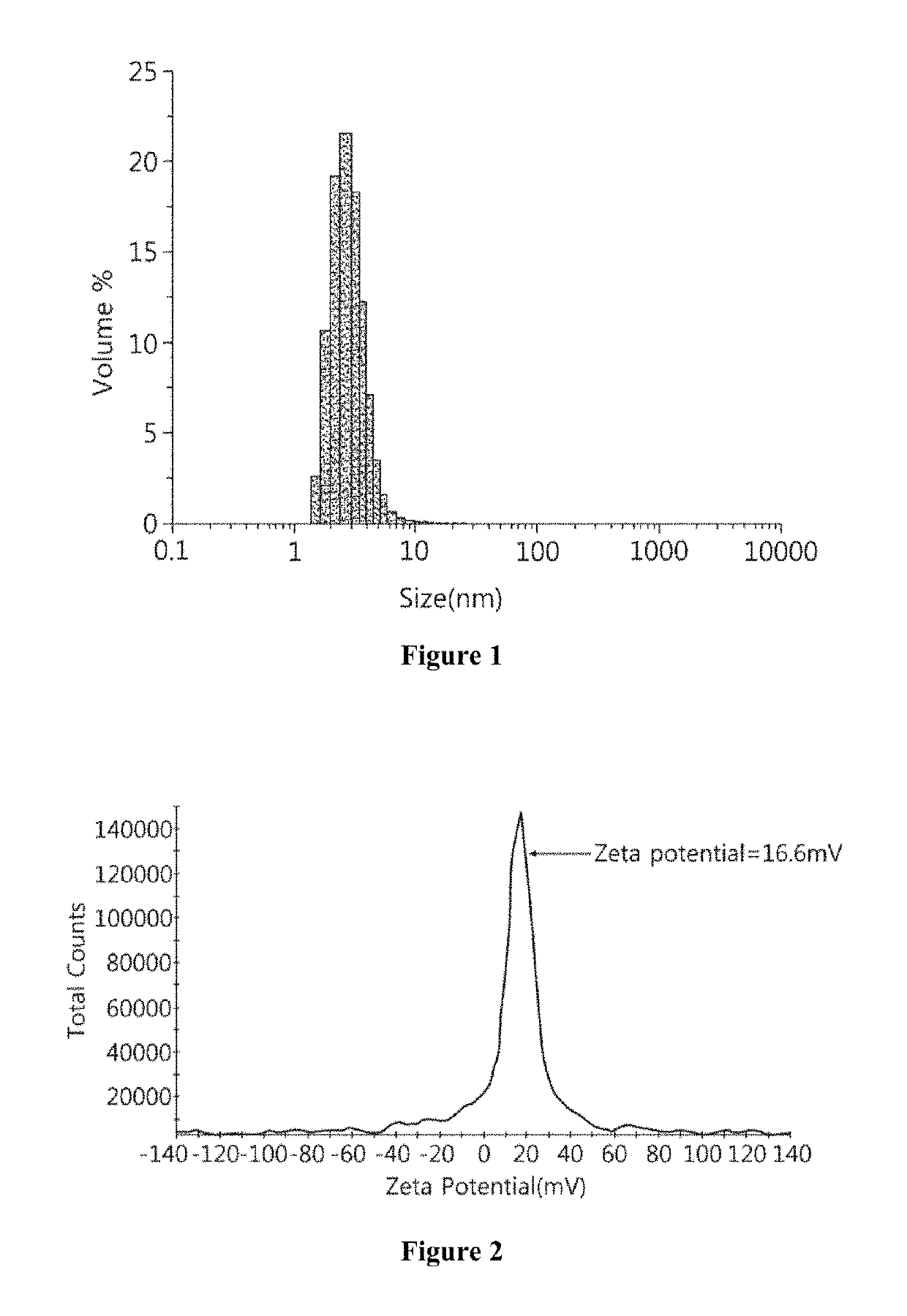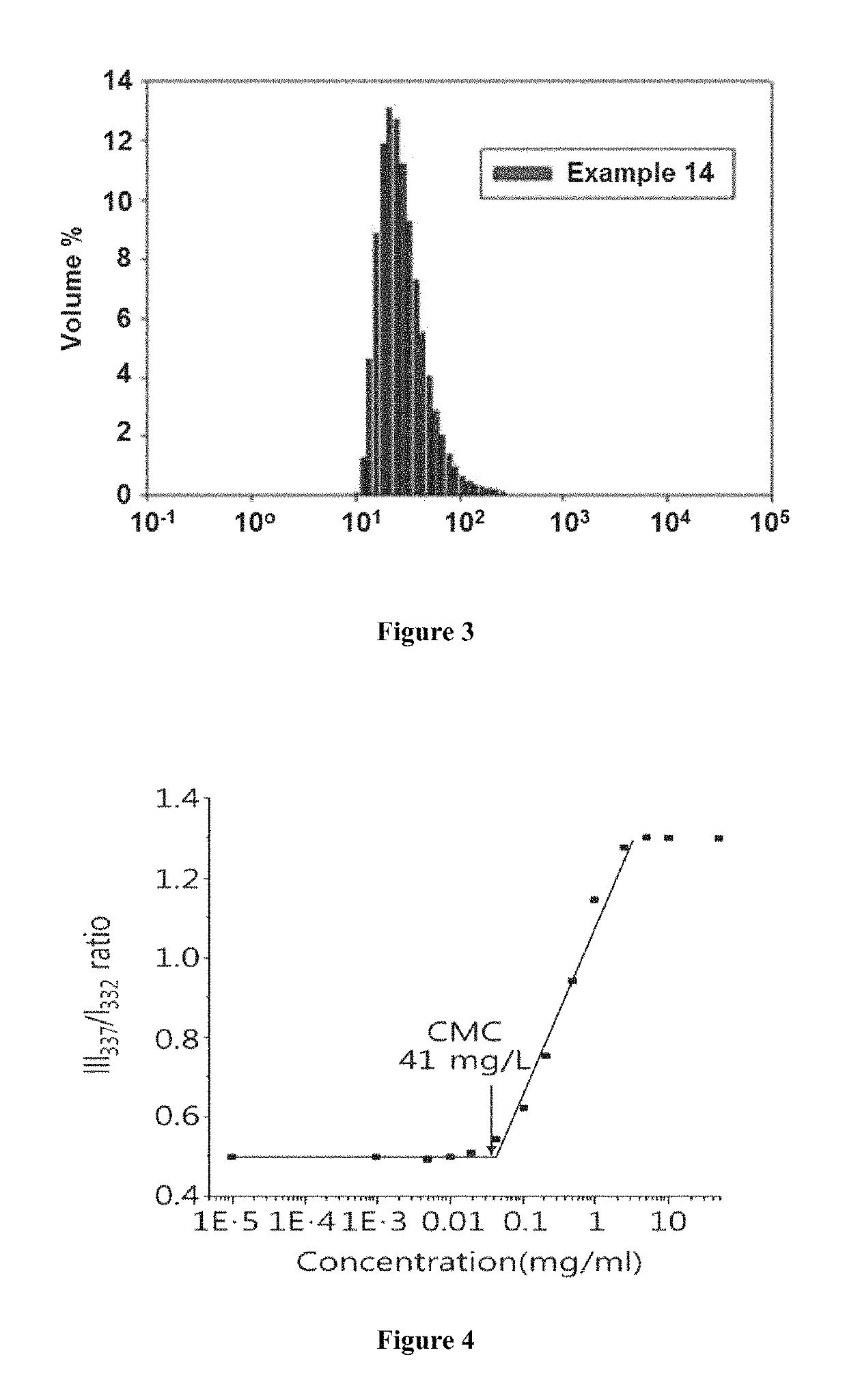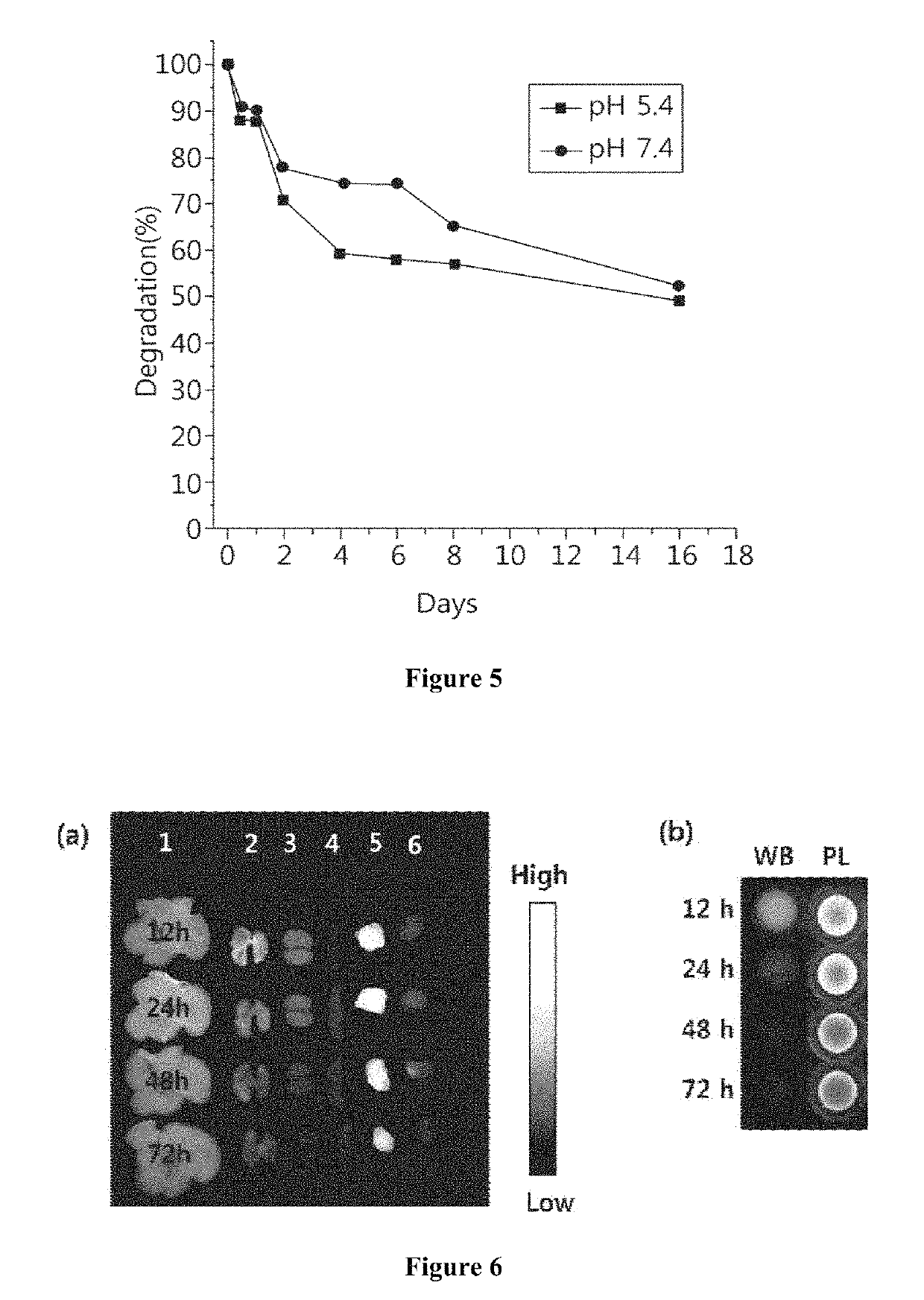Cationic polyphosphazene compound, polyphosphazenes-drug conjugate compound and method for preparing same
a technology of phosphazene and compound, which is applied in the field of cationic polyphosphazene compound, polyphosphazenes-drug conjugate compound and method for preparing same, can solve the problems of limiting the sustainable efficacy of drugs, reducing water solubility and some toxicity, and affecting the survival rate of drugs, so as to achieve maximum drug efficacy, high tumor selectivity, and high selectivity
- Summary
- Abstract
- Description
- Claims
- Application Information
AI Technical Summary
Benefits of technology
Problems solved by technology
Method used
Image
Examples
example 10
of 2′-aconitic docetaxel NHS ester
[0154]Aconitic anhydride (3.12 g, 20 mmol), docetaxel (8.03 g, 10 mmol) and a catalyst DPTS (dimethylaminopyridine / p-toluenesulfonic acid) (6.0 g, 20 mmol) were vacuum-dried for 4 h and cooled to −10° C. and then completely dissolved in dried tetrahydrofuran (100 ml). To this solution was slowly added DIC (N,N′-diisopropylcarbodiimide) (2.5 g, 20 mmol) dissolved also in dried tetrahydrofuran. The mixed reaction solution was reacted for 6 h at −10° C. and then for 6 to 12 h at 0° C. The progress of the reaction was monitored by TLC using a solvent mixture of dichloromethane: methanol (95:5) until no free docetaxel is detected. After confirmed completion of the reaction, excess amount of NHS (N-hydroxysuccinimide) (11.5 g, 100 mmol) and a large excess of basic DIPEA(diisopropyl ethyl amine) were added to the above reaction solution and the reaction mixture was further reacted for 12 h. The reaction mixture was finally subjected to vacuum evaporation t...
example 11
of 2′-aconitic paclitaxel-NHS ester
[0158]According to the same procedure as described in Example 10, the desired product of the precursor composed of 2′-acconitic-paclitaxel-NHS ester was prepared using aconitic anhydride (3.12 g, 20 mmol), paclitaxel (8.53 g, 10 mmol), DPTS (5.88 g, 20 mmol), NHS (11.5 g, 100 mmol), DIC (2.52 g, 20 mmol) and DIPEA (10 ml).
[0159]Composition: C55H58N2O19
[0160]Elemental analysis data (%): C, (61.90); H, (5.75); N, (2.80). Theoretical value: (62.85); H, (5.56); N, (2.67).
[0161]1H-NMR spectra (CDCl3) (δ, ppm): 1.13 ppm (s, 3H, C17-CH3), 1.24 ppm (s, 3H, C16-CH3), 1.34 ppm (s, 9H, C60-t Bu), 1.75 ppm (s, 3H, C19-CH3), 1.96 ppm (s, 3H, C18-CH3), 2.18 ppm (d, 2H, C14-CH2), 2.43 ppm (s, 3H, C22-CH3), 2.64 (t, 4H, NHS—CH2CH2), 2.92 (s, 2H, aconitic-CH2), 4.21 ppm (d, 1H, C20-CHa), 4.24 ppm (m, 1H, C7-CH), 4.32 ppm (d, 1H, C20-CHb), 4.95 ppm (dd, 1H, C5-CH), 5.23 ppm (d, 1H, C10-CH), 5.40 ppm (d, 1H, C30-CH), 5.69 ppm (d, 1H, C2-CH), 6.40-6.68 (m, 1H, aconit...
example 12
of 2′-aconitic camptothecin-NHS ester
[0162]According to the same procedure as described in Example 10, the desired product of the precursor composed of 2′-acconitic-camptothecin-NHS ester was prepared using aconitic anhydride (3.12 g, 20 mmol), camptothecin (3.48 g, 10 mmol), DPTS (5.88 g, 20 mmol), NHS (11.5 g, 100 mmol), DIC (2.52 g, 20 mmol) and DIPEA (10 ml).
[0163]Composition: C30H23N3O11
[0164]Elemental analysis data (%): C, (60.29); H, (3.98); N, (6.57). Theoretical value: (59.90); H, (3.85); N, (6.99).
[0165]1H-NMR spectra (CDCl3) (δ, ppm): 0.9 (t, 3H, C18-CH3), 2.0 (m, 2H, C19-CH2), 2.64 (t, 4H, NHS—CH2CH2), 2.92 (s, 2H, aconitic-CH2), 4.20 (d, 2H, C5-CH2), 4.76 (m, 2H, C22-CH2), 6.40-6.68 (m, 1H, aconitic-CH), 6.70 (s, 1H, C14-CH), 7.59 (s, 1H, C11-CH), 7.80 (m, 2H, C12-CH; C7-CH), 8.0 (m, 2H, C9-CH; C12-CH).
PUM
| Property | Measurement | Unit |
|---|---|---|
| molecular weight | aaaaa | aaaaa |
| particle size | aaaaa | aaaaa |
| pH | aaaaa | aaaaa |
Abstract
Description
Claims
Application Information
 Login to View More
Login to View More - R&D
- Intellectual Property
- Life Sciences
- Materials
- Tech Scout
- Unparalleled Data Quality
- Higher Quality Content
- 60% Fewer Hallucinations
Browse by: Latest US Patents, China's latest patents, Technical Efficacy Thesaurus, Application Domain, Technology Topic, Popular Technical Reports.
© 2025 PatSnap. All rights reserved.Legal|Privacy policy|Modern Slavery Act Transparency Statement|Sitemap|About US| Contact US: help@patsnap.com



